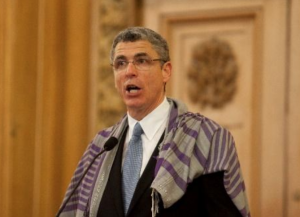When I was a kid, I wasn’t very enthusiastic about going to synagogue, but I especially hated having to get dressed up for temple. Putting on fancy clothes just reinforced the formality and discomfort of the whole experience. If prayer was a matter of the heart, I wondered, what difference did it make if I wore jeans or a jacket and tie? The real question, however, is this: What clothes, if any, add meaning to my spirituality? This week’s parashah, T’tzaveh, has a lot to say about holy attire.
It’s rather curious that our holiest text goes into painstaking detail about what the ancient leaders of our people wore while leading ritual. Regular priests were instructed to wear special tunics, sashes, headdresses, and breeches while Moses’ brother Aaron, the first high priest, wore a breastplate, an ephod (a special garment to attach the breastplate), a robe, and a headpiece – in addition to the clothes of the regular priests.
As we are told in Exodus 28:29, the specially designed breastpiece was laden with meaning: “Aaron shall carry the names of the children of Israel on the breastpiece of decision over his heart….” Midrash Tanchuma elaborates: “When Aaron had to make a decision regarding a fellow Israelite, he was to consult not only the rule book but his heart as well….” (Tanchuma Sh’mot 27). I imagine the breastpiece wasn’t only impressive to behold, but more importantly, it helped the high priest remain focused on what mattered most.
A few years ago, I traveled to Darfuri refugee camps in eastern Chad with a small group of rabbis and Ruth Messinger, who at the time headed the American Jewish World Service. As we were leaving one refugee camp after hearing soul-searing stories of the lucky survivors of genocide, I asked our driver to stop so I could buy a tallit. My colleagues chided me that surely there were no tallitot for sale in the middle of Africa. I persisted, however, finding a colorful piece of cloth in shades of purple and grey, which I bought for a couple of dollars.
Upon returning home, my daughter Sarah and I tied the tzitzit onto the four corners of the cloth, symbolizing our obligation to bring the four corners of the earth together in our hearts and in our deeds. I made a vow to wear this tallit until the genocide in Darfur finally ends. Although the tallit’s fabric is nearly worn thin, I continue to wear it as a daily reminder of God’s vulnerable children around the globe whose lives depend on our willingness to stand up and advocate for them. My Darfur tallit never fails to focus my attention on what matters most.
The ancient high priest wore a miter (miẓnefet), and ordinary priests wore a hat (migba’at). Today many Jews wear a kippah or yarmulke as a head covering – some only when they pray or study, others wear them all the time. At one time, kippot were only for men, but now it is quite common in non-Orthodox communities for women to wear them as well. The kippot I wear all come from a tiny store on Ben Yehuda Street in Jerusalem. My tallit connects me to my global obligations while my kippah reminds me of my deep connection to the Jewish state.
Speaking of kippot, I was surprised to learn that until very recently, wearing head coverings in the U.S. Congress was forbidden. Hats have been banned from the House chamber of the Capitol for nearly two centuries, meaning that observant Jews, Muslims, and Sikhs would be prohibited from wearing religious head coverings while serving in Congress. Under a new proposal, the rule would be relaxed to allow religious headwear, such as a hijab, kippah or turban to be worn within the chamber. With 34 Jews, three Muslims, and three Hindus serving in the 116th Congress, I am heartened to know both that our elected officials are from more diverse backgrounds than ever before and also that they can serve and observe their faith by wearing the various head coverings dictated by their religious traditions.
T’tzaveh reminds us that sacred garments can add considerable meaning to our lives. My tallit and kippah not only connect me to our world, but also remind me of my obligations within it.
I am hopeful that together we can continue to shape our society so that all Americans can wear the sacred garments of their tradition in prayer and in public, but most of all, with pride and without fear.

